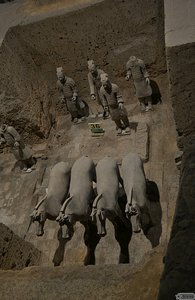Advertisement
Published: September 11th 2017

 horses and horsemen
horses and horsemen
the chariot have disapear because it was made of woodGeo: 34.27, 108.9
One of the 'not to be missed' spot in China: the famous army of Terracotta warriors. And once you see it you understand why it is well worth a visit. I don't really have words to describe it. The site was built by an emperor who was rather megalo. Qin Shi Huan (260-210 BC) got on the throne at the age of 13 and decided to unify China, which he did! And thus became the first emperor of China. He was a great strategist. In the meantime he ordered the construction of his mausoleum and it would have to be magnificent. He wanted to be buried with a representation of its army, and in life-size please! So workers/artist had to build soldiers, archers, horses, horsemen and chariots which were later buried why the emperor. The work took over 38 years (from 246 to 208 BC) to be completed and Emperor Qin died before its completion.
Each warriors figure is finely executed. You can pay attention to their hair-do and their shoes, they indicate their rank and their role. I can't remember exactly what is what (sorry). The terracotta warriors are impressive but the work behind their restoration is also
to be acknowledge. Most of them have to be glued back together. It's like a gigantic 3D puzzle! The reason why the statues are in such a bad state lies in the construction process. The structure of the mausoleum was in wood instead of stone. Thus when it was burned down by enemies, the wood structure collapse onto the warrior reducing them into pieces.
There is a total of 3 pits that you can visit. We started our visit with the smallest (pit 3), and ended with the biggest (pit 1). I think it was a good way of doing it, because the smaller pit is more intimate and you get a close view at the warriors and horses. With pit 2 you start to realise the scale of the site and pit 1 is just humongous! It blows your mind away.
Un des sites à ne pas manquer en Chine : la fameuse armée de terre cuite. Et une fois que vous l'avez vu, c'est facile de comprendre pourquoi, ça vaut vraiment le coup. Il n'y a pas vraiment de mots pour la décrire. Le site fût construit par un empereur mégalo. Qin Shi Huan (260-210 avant JC) monta sur le trône à l'âge de 13 ans et décida d'unifier la Chine. Chose dite, chose faite…il devient donc le premier Empereur de Chine. Dès le début de son règne, il ordonna la construction de son mausolée qui se devait d'être grandiose ! Il voulait être enterré avec une représentation de son armée et en taille réelle, s'il-vous-plaît ! Donc les artisans ont réalisé un nombre impressionnant de soldats, archers, chevaux et charriots. Le travail a pris plus de 38 ans (de 246 à 208 avant JC) et l'empereur est décédé avant sa finition.
Chaque personnage est finement exécuté et peint. Vous pouvez regarder attentivement les différentes coiffures et les chaussures, qui signalent le rang et le rôle de chacun. Désolé, je ne me rappelle plus trop quoi est quoi. L'armée de terre cuite est impressionnante mais il ne faut pas oublier de mentionner le travail titanesque qui a permis sa restauration. En effet, la plupart des statues ont dû être recollées petit bout par petit bout, un puzzle 3D grandeur nature ! La raison de leur état pitoyable réside dans la manière dont le mausolée a été construit : le toit qui protégeait l'armée était en bois et a été brulé par
les ennemis de l'empire, ensevelissant l'armée entière pour des siècles.
On peut visiter trois puits. Nous avons commencé par le puits n°3, le plus petit et avons fait le puits n°1 (le plus grand) en dernier. Je pense que c'était une bonne façon de le visiter car le petit puits permet de voir les soldats et chevaux d'un peu plus près sans être complètement noyé par l'immensité du puits n°1. Le nombre de soldats est juste ahurissant !
Comment on picture:
- horses and horsemen: the chariot have disapear because it was made of wood // le chariot a disparu car il été fait en bois
Advertisement
Tot: 0.093s; Tpl: 0.014s; cc: 12; qc: 28; dbt: 0.0314s; 1; m:domysql w:travelblog (10.17.0.13); sld: 1;
; mem: 1.1mb






















